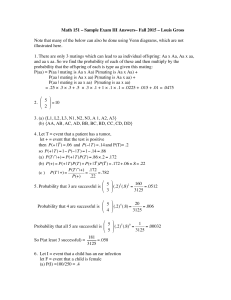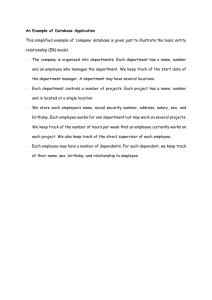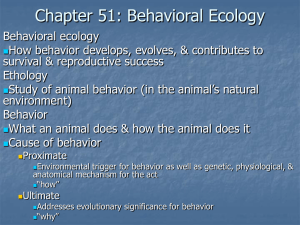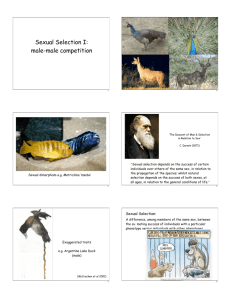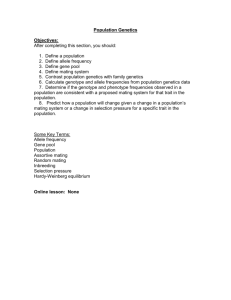Paper folding curves, mating, and an endomorphism of CP Volodymyr Nekrashevych
advertisement
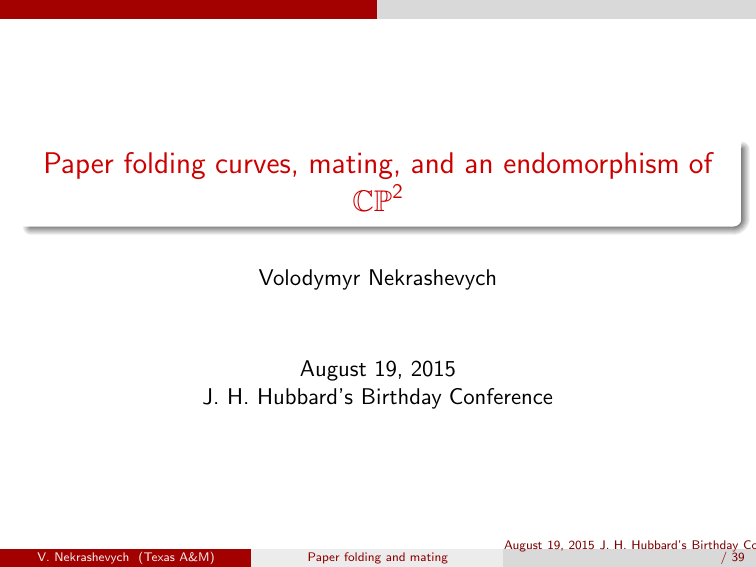
Paper folding curves, mating, and an endomorphism of
CP2
Volodymyr Nekrashevych
August 19, 2015
J. H. Hubbard’s Birthday Conference
V. Nekrashevych (Texas A&M)
Paper folding and mating
August 19, 2015 J. H. Hubbard’s Birthday Co
/ 39
The map
Consider the map F : C2 −→ C2 :
F (z, p) =
2 !
p−1 2
2z
−1 ,
.
p+1
p+1
It can be extended to an endomorphism of PC2 given by
F [z : p : u] = [(2z − p − u)2 : (p − u)2 : (p + u)2 ].
Its critical locus is 2z − p − u = 0, p = u, and p + u = 0. Their orbits are
{2z − p − u = 0} 7→ {z = 0} 7→ {z = u} 7→ {z = p} 7→ {z = p},
{p = −u} 7→ {u = 0} 7→ {p = u} 7→ {p = 0} 7→ {p = u}.
V. Nekrashevych (Texas A&M)
Paper folding and mating
August 19, 2015 J. H. Hubbard’s Birthday Co
/ 39
The map
2 2 p−1
− 1 , p+1
projects in the second
The map F (z, p) =
2
coordinate to the rational function f (p) = p−1
.
p+1
V. Nekrashevych (Texas A&M)
2z
p+1
Paper folding and mating
August 19, 2015 J. H. Hubbard’s Birthday Co
/ 39
The map
V. Nekrashevych (Texas A&M)
Paper folding and mating
August 19, 2015 J. H. Hubbard’s Birthday Co
/ 39
The map
Let J2 be the Julia set of F , i.e., the set of points (z, p) ∈ PC2 such that
{F ◦n |U : n ≥ 0} is not a normal family for any neighborhood U of (z, p).
Denote
by J1 the accumulation set of the full inverse orbit
S
−n (z , p ) for a generic (z , p ). We have J ⊂ J .
F
0 0
0 0
1
2
n≥1
Using Kobaiashi hyperbolicity, one can show that there is an orbifold
metric on a neighborhood of J1 such that F is strictly expanding.
Projection of J1 by (z, p) 7→ p is the Julia set of f (p) = (p − 1)2 /(p + 1)2 ,
while projection of J2 is the whole Riemann sphere.
V. Nekrashevych (Texas A&M)
Paper folding and mating
August 19, 2015 J. H. Hubbard’s Birthday Co
/ 39
The map
On the first coordinate z we get compositions of polynomials
2
2
p−1
2z
− 1 , where p runs through an orbit of f (p) = p+1
.
hp (z) = p+1
This makes it possible to draw the fibers of the projections (z, p) 7→ p of
the Julia sets J2 and J1 .
V. Nekrashevych (Texas A&M)
Paper folding and mating
August 19, 2015 J. H. Hubbard’s Birthday Co
/ 39
The map
V. Nekrashevych (Texas A&M)
Paper folding and mating
August 19, 2015 J. H. Hubbard’s Birthday Co
/ 39
The map
V. Nekrashevych (Texas A&M)
Paper folding and mating
August 19, 2015 J. H. Hubbard’s Birthday Co
/ 39
The iterated monodromy group
Iterated monodromy groups
The main tool for studying F will be the iterated monodromy groups. Let
f : M1 −→ M be a covering map such that M1 ⊂ M, e.g., M is the
complement of the post-critical set. Consider the tree of the backward
orbit of a point t ∈ M
Every loop γ ∈ π1 (M, t) defines an automorphism of the tree. The group
of such automorphisms is the IMG (f ).
August 19, 2015 J. H. Hubbard’s Birthday Co
V. Nekrashevych (Texas A&M)
Paper folding and mating
/ 39
The iterated monodromy group
Suppose that G is the iterated monodromy group of an expanding map f ,
and let S be a finite generating set of G . Consider the graphs of action Γn
of G on the levels f −n (t) of the tree. Its set of vertices is f −n (t), and we
connect two vertices v1 , v2 by an edge if one is the image of the other
under the action of a generator s ∈ S.
The graphs Γn converge in an appropriate sense to the accumulation set of
backward orbits of f . The limit of the graphs Γn is called the limit space
of the group G .
V. Nekrashevych (Texas A&M)
Paper folding and mating
August 19, 2015 J. H. Hubbard’s Birthday Co
/ 39
The iterated monodromy group
IMG (F )
Theorem
The iterated monodromy group IMG (F ) is generated by the wreath
recursion
α = σ(β, β, βα, αβ),
β = (1, βαβ, α, 1),
γ = (γ, β, γ, β),
P = π,
S
= σπ(Pτ −1 , P, S −1 τ −1 , S −1 ),
where σ = (12)(34), π = (13)(24), and τ = γαβ.
α, β, γ are loops inside the z-planes p = p0 , and S, P are loops in the
p-plane.
V. Nekrashevych (Texas A&M)
Paper folding and mating
August 19, 2015 J. H. Hubbard’s Birthday Co
/ 39
The iterated monodromy group
The skew product structure of the map F is reflected in the structure of
the group IMG (F ). The subgroup G generated by α, β, γ is normal in
IMG (F ), the quotient IMG (F ) /G is naturally isomorphic to IMG (f ).
Restrictions of G onto invariant binary subtrees are groups
Gw = hαw , βw , γw i acting on binary trees and parametrized by sequences
w ∈ {0, 1}∞ . They are iterated monodromy groups of backward
2
2z
− 1 . The family
compositions of the polynomials hp (z) = p+1
{Gw }w ∈{0,1}∞ has interesting group-theoretic properties: The isomorphism
classes of groups Gw (inside the family) are countable. The profinite
completions of the groups Gw are isomorphic. The Cayley graphs of Gw
are “locally isomorphic”.
V. Nekrashevych (Texas A&M)
Paper folding and mating
August 19, 2015 J. H. Hubbard’s Birthday Co
/ 39
The iterated monodromy group
Connected components of the limit space of G are the fibers of the map
from J1 to the Julia set of f (p) under the projection (z, p) 7→ p.
The graphs of the action of Gw on the levels of the binary tree
approximate the connected components of the limit space of G, i.e., the
fibers of the Julia set of F . The limit space of G is obtained by
“disintegrating” the base of the fibration J1 −→ Jf into a Cantor set,
while keeping the fibers intact.
V. Nekrashevych (Texas A&M)
Paper folding and mating
August 19, 2015 J. H. Hubbard’s Birthday Co
/ 39
The iterated monodromy group
V. Nekrashevych (Texas A&M)
Paper folding and mating
August 19, 2015 J. H. Hubbard’s Birthday Co
/ 39
The iterated monodromy group
V. Nekrashevych (Texas A&M)
Paper folding and mating
August 19, 2015 J. H. Hubbard’s Birthday Co
/ 39
The iterated monodromy group
V. Nekrashevych (Texas A&M)
Paper folding and mating
August 19, 2015 J. H. Hubbard’s Birthday Co
/ 39
Mating
External angles
Each fiber J(p) of the projection (z, p) 7→ p of J1 is a dendrite, and we
can consider the corresponding Carathéodory loop) from the unit circle to
J(p), which is unique up to rotation of the circle.
We get a map from a bundle of circles over the Julia set of f to J1 .
In terms of self-similar groups it is induced by the embedding
hτ, P, Si ,→ IMG (F ). The bundle of circles is the limit space of
R = hτ, P, Si.
V. Nekrashevych (Texas A&M)
Paper folding and mating
August 19, 2015 J. H. Hubbard’s Birthday Co
/ 39
Mating
V. Nekrashevych (Texas A&M)
Paper folding and mating
August 19, 2015 J. H. Hubbard’s Birthday Co
/ 39
Mating
The limit space of R is obtained by taking the direct product of R/Z by
the Cantor set {L, R}−ω , and then making identifications shown on the
next picture, where numbers show rotations of circles.
The corresponding dynamical system acts as a shift on the Cantor set base
(and as f (p) on the Julia set) and as angle doubling on the circles.
V. Nekrashevych (Texas A&M)
Paper folding and mating
August 19, 2015 J. H. Hubbard’s Birthday Co
/ 39
Mating
V. Nekrashevych (Texas A&M)
Paper folding and mating
August 19, 2015 J. H. Hubbard’s Birthday Co
/ 39
Mating
Preimages of a point (z, p) ∈ J1 in the bulde of Carathéodory loops are
called external rays landing on (z, p).
Proposition
2
1−p
Denote by q1 the fixed point ≈ 0.2956 of f (p) = 1+p
. If p0 belongs to
S
−n
(q1 ), then there are two external rays landing on (p0 , p0 ). The
n≥0 f
1
, where k is the
difference of angles of these external rays is equal to 2k−1
3
smallest integer such that f k (p0 ) = q1 . In all the other cases there is a
unique ray landing on (p0 , p0 ).
V. Nekrashevych (Texas A&M)
Paper folding and mating
August 19, 2015 J. H. Hubbard’s Birthday Co
/ 39
Mating
V. Nekrashevych (Texas A&M)
Paper folding and mating
August 19, 2015 J. H. Hubbard’s Birthday Co
/ 39
Mating
V. Nekrashevych (Texas A&M)
Paper folding and mating
August 19, 2015 J. H. Hubbard’s Birthday Co
/ 39
Mating
Mating
Take two copies of J(p). Let γ : R/Z −→ J(p) be the Carathéodory loop,
and let λ ∈ R be such that γ(λ) = (p, p).
Paste one copy of J(p) to the other by identifying γ(θ) in one copy with
γ(2λ − θ) in the other, i.e., reflecting one Carathéodory loop along the
diameter containing a ray landing on (p, p).
These identifications agree with the dynamics, since the line z = p is
F -invariant. Hence we get a bundle of matings over the Cantor set
{L, R}−ω together with a skew product dynamics on it.
The case of the fixed point p ≈ −0.648 + 1.721i was studied by J. Milnor.
He showed that mating of the corresponding polynomial hp (z) with itself
is a Lattès example, and that the image of the Carathéodory loop is the
“dragon curve”.
V. Nekrashevych (Texas A&M)
Paper folding and mating
August 19, 2015 J. H. Hubbard’s Birthday Co
/ 39
Mating
Algebraically, the mating corresponds to considering a group Gb generated
by two copies of G:
α1 = σ(β1 , β1 , β1 α1 , α1 β1 ),
β1 = (1, β1 α1 β1 , α1 , 1),
γ1 = (γ1 , β1 , γ1 , β1 ),
and
α2 = σ(β2 α2 , α2 β2 , β2 , β2 ),
β2 = (α2 , 1, 1, β2 α2 β2 ),
γ2 = (γ2 , β2 , γ2 , β2 ).
V. Nekrashevych (Texas A&M)
Paper folding and mating
August 19, 2015 J. H. Hubbard’s Birthday Co
/ 39
Mating
The nucleus of Gb consists of 122 elements
{1, αi , βi , γi , αβi i , γiαi , γiβi , βiαi ,
β
α
α
β
αj βj
αi j , βi j , γi j , γi j , αi
αj βj
, γiαi βi , βi
,
αi βi
C
αi
, C αi , C βi , C τ , αi βj αj βj }∪
αB
i , αi , B, C , B , B
{αi βi , αi γi , βi γi , βi αj , βi γj , αi γj ,
τ, βi αi βj , βi αi αj , αi βi αj βj , βi γi αj , αi τ, βi τ, αi B, βi C , βi αi B,
βi τ βj , C τ, αi C τ, βi C τ }±1 ,
where B = β1 β2 , C = γ1 γ2 , τ = γ1 α1 β1 = γ2 α2 β2
V. Nekrashevych (Texas A&M)
Paper folding and mating
August 19, 2015 J. H. Hubbard’s Birthday Co
/ 39
Mating
The connected components of the limit space of Gb are the results of
matings described above. Consider the subgroup H generated by A = α2 ,
B = β1 β2 , and C = γ1 γ2 . We have α1 = CAB = BAC . Passing to the
subgroup H corresponds to considering only the loops not intersecting the
Levy cycle of the formal mating.
Proposition
The subgroup H is isomorphic to the virtually abelian group of
transformations of C of the form z 7→ ±z + q, where q ∈ Z[i ]. The graphs
of the action of Gb (up to additional loops) coincide with the graphs of H.
V. Nekrashevych (Texas A&M)
Paper folding and mating
August 19, 2015 J. H. Hubbard’s Birthday Co
/ 39
Mating
V. Nekrashevych (Texas A&M)
Paper folding and mating
August 19, 2015 J. H. Hubbard’s Birthday Co
/ 39
Mating
V. Nekrashevych (Texas A&M)
Paper folding and mating
August 19, 2015 J. H. Hubbard’s Birthday Co
/ 39
Mating
The graphs of action of Gb are disjoint unions of the graphs of actions of
the two copies of G.
V. Nekrashevych (Texas A&M)
Paper folding and mating
August 19, 2015 J. H. Hubbard’s Birthday Co
/ 39
Mating
The connected components of the limit space of Gb are quotients of the
action of H on C, i.e., “pillowcases” homeomorphic to the sphere. The
limit dynamical system acts on them as multiplication by 1 + i or 1 − i ,
depending on the last letter of the point in the Cantor set base.
V. Nekrashevych (Texas A&M)
Paper folding and mating
August 19, 2015 J. H. Hubbard’s Birthday Co
/ 39
Mating
The graphs of action of Gb are adjacency graphs of squares of one color in
a checkerboard pattern on the pillowcase.
V. Nekrashevych (Texas A&M)
Paper folding and mating
August 19, 2015 J. H. Hubbard’s Birthday Co
/ 39
Dragon curves
Since the graphs of action of G are trees, there exists an Eulerian path
going around the checkerboard squares, so that the tree is the adjacency
graph of the squares that are on one side of the path:
V. Nekrashevych (Texas A&M)
Paper folding and mating
August 19, 2015 J. H. Hubbard’s Birthday Co
/ 39
Dragon curves
V. Nekrashevych (Texas A&M)
Paper folding and mating
August 19, 2015 J. H. Hubbard’s Birthday Co
/ 39
Dragon curves
V. Nekrashevych (Texas A&M)
Paper folding and mating
August 19, 2015 J. H. Hubbard’s Birthday Co
/ 39
Dragon curves
V. Nekrashevych (Texas A&M)
Paper folding and mating
August 19, 2015 J. H. Hubbard’s Birthday Co
/ 39
Dragon curves
V. Nekrashevych (Texas A&M)
Paper folding and mating
August 19, 2015 J. H. Hubbard’s Birthday Co
/ 39
Dragon curves
V. Nekrashevych (Texas A&M)
Paper folding and mating
August 19, 2015 J. H. Hubbard’s Birthday Co
/ 39
Dragon curves
A connection of the paper folding curves (for varying folding directions)
with binary numeration systems on C with varying bases 1 + i or 1 − i was
described by C. Davis and D. Knuth (1965, J. Recreational Math.).
V. Nekrashevych (Texas A&M)
Paper folding and mating
August 19, 2015 J. H. Hubbard’s Birthday Co
/ 39

